| dc.contributor.advisor | Regalado Cossio, Liliana Alejandrina | |
| dc.contributor.author | Quichua Chaico, David | |
| dc.date.accessioned | 2022-01-11T17:41:56Z | |
| dc.date.available | 2022-01-11T17:41:56Z | |
| dc.date.created | 2021 | |
| dc.date.issued | 2022-01-11 | |
| dc.identifier.uri | http://hdl.handle.net/20.500.12404/21253 | |
| dc.description.abstract | La presente tesis estudia la relación de las poblaciones indígenas de Huamanga (actual
región Ayacucho) con el Estado inca y los Austrias.
Mediante la revisión de documentos en archivos regionales, nacionales e internacionales
proponemos que la implantación de los proyectos imperiales de los incas y los Austrias
fueron relativamente modificados por el accionar de los indígenas y en ambas
administraciones se mantuvieron los llaqtakunapa yachaynin (conocimientos de los
pueblos).
Los incas al incorporar a los Lucanas, Soras, Angaraes, Chocorbos, Chancas y
Tanquiguas establecieron sus deidades imperiales, mitimaes y tributos, pero las etnias
mantuvieron sus autonomías, deidades regionales y estructuras internas de dualidad y
tripartición. Igualmente, si los Austrias establecieron encomiendas, reducciones, mitas y
tributos también fue un Estado flexible y facilitó la participación de los indígenas. Las
encomiendas respetaron las estructuras internas de las etnias y los mitimaes; durante las
reducciones muchos pueblos se mantuvieron en sus asentamientos prehispánicos o
retornaron a sus ñauplallaqtas; y obtuvieron tierras comunales avaladas por un título, los
cuales fueron defendidos por las y los curacas.
A su vez, ambos Estados no solo implementaron cambios, sino que también permitieron
la continuidad de los llaqtakunapa yachaynin. De tal manera, el cultivo de maíz, la
labor de los chasquis y la renovación de los puentes facilitaron el auge económico y
administrativo del Estado inca y los Austrias. | es_ES |
| dc.description.abstract | This thesis studies the relationship of the indigenous populations of Huamanga (current
Ayacucho region) with the Inca State and the Austrias.
By reviewing documents in regional, national and international archives, we propose
that the implantation of the imperial projects of the Incas and the Habsburgs were
relatively modified by the actions of the indigenous people and in both administrations
the llaqtakunapa yachaynin (knowledge of the peoples) were maintained.
The Incas by incorporating the Lucanas, Soras, Angaraes, Chocorbos, Chancas and
Tanquiguas established their imperial deities, mitimaes and tributes, but the ethnic
groups maintained their autonomies, regional deities and internal structures of duality
and tripartition. Likewise, if the Habsburgs established encomiendas, reducciones,
mitas, and tributes, it was also a flexible state and facilitated the participation of the
indigenous people. The encomiendas respected the internal structures of the ethnic
groups and the mitimaes; during the reductions many peoples remained in their preHispanic settlements or returned to their ñauplallaqtas; and they obtained communal
lands endorsed by a title, which were defended by the curacas.
In turn, both states not only implemented changes, but also allowed the llaqtakunapa
yachaynin to continue. In this way, the cultivation of corn, the work of the chasquis and
the renovation of the bridges facilitated the economic and administrative boom of the
Inca State and the Habsburgs. | es_ES |
| dc.language.iso | spa | es_ES |
| dc.publisher | Pontificia Universidad Católica del Perú | es_ES |
| dc.rights | info:eu-repo/semantics/closedAccess | es_ES |
| dc.subject | Huamanga (Ayacucho : Provincia)--Historia--Colonia | es_ES |
| dc.subject | Huamanga (Ayacucho : Provincia)--Historia--Época prehispánica | es_ES |
| dc.subject | Indios del Perú--Ayacucho--Historia | es_ES |
| dc.title | Convivencias y desafíos: los indígenas de Huamanga en la administración inca y los Austrias | es_ES |
| dc.type | info:eu-repo/semantics/doctoralThesis | es_ES |
| thesis.degree.name | Doctor en Historia con mención en Estudios Andinos | es_ES |
| thesis.degree.level | Doctorado | es_ES |
| thesis.degree.grantor | Pontificia Universidad Católica del Perú. Escuela de Posgrado | es_ES |
| thesis.degree.discipline | Historia con mención en Estudios Andinos | es_ES |
| renati.advisor.dni | 07914557 | |
| renati.advisor.orcid | https://orcid.org/0000-0003-4319-0791 | es_ES |
| renati.author.dni | 44706999 | |
| renati.discipline | 222058 | es_ES |
| renati.juror | Curatola Petrocchi, Marco | es_ES |
| renati.juror | Regalado Cossio, Liliana Alejandrina | es_ES |
| renati.juror | Hernández Astete, Francisco Javier | es_ES |
| renati.juror | Salas Olivari, Miriam Alicia | es_ES |
| renati.juror | Pereyra Chávez, Nelson Ernesto | es_ES |
| renati.level | https://purl.org/pe-repo/renati/level#doctor | es_ES |
| renati.type | https://purl.org/pe-repo/renati/type#tesis | es_ES |
| dc.publisher.country | PE | es_ES |
| dc.subject.ocde | https://purl.org/pe-repo/ocde/ford#6.01.01 | es_ES |





